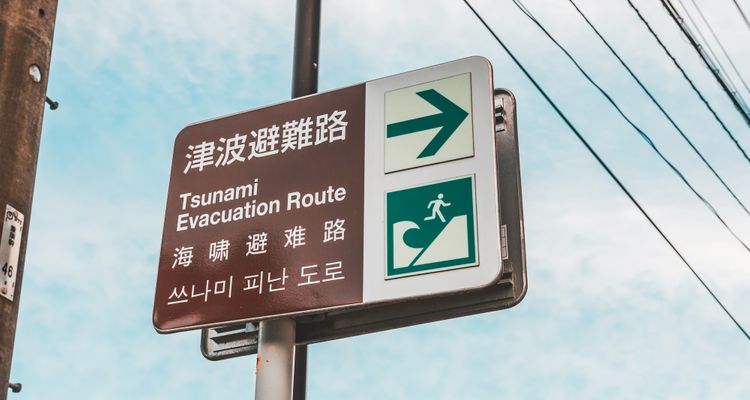All in all, life in Japan is incredibly safe, but have you thought about what to do in the event of a natural disaster? If you haven’t, then use the advice and tips in this article to protect yourself from the wrath of Mother Nature.
According to the 2018 Japan Earthquake Forecast Map released by the Japanese Headquarters for Earthquake Research Promotion, the Tokyo metropolitan area (which includes Tokyo Prefecture and the cities of Yokohama, Mito, and Chiba), has a high probability of an earthquake of lower 6 intensity or above in the next 30 years.
Keeping that in mind, here’s how to keep safe when a natural disaster strikes in Japan.

Carry ID and Stay Connected
In Japan, all foreign residents are required to carry on their persons a form of ID like a Residence Card. Not only is it mandated by the law, it can help you access all forms of official assistance in the aftermath of a natural disaster.
Additionally, consider getting pocket Wi-Fi and carrying a phone charger or portable battery so that you can get up-to-date information as well as notify friends and family of your situation.
There are several free apps with English language support that provide earthquake and tsunami alerts to those with limited Japanese ability. Download these three apps and get acquainted with them before coming to Japan:
NHK World TV: offers earthquake and tsunami warnings alongside updates on weather-related incidents.
Yurekuru Call: uses earthquake early warnings and real-time information from registered users in regards to the intensity of an earthquake.
Japan Shelter Guide: provides real-time information on earthquakes and tsunamis as well as the location of more than 100,000 shelters, medical facilities, and water supplies across Japan.
Recognize These Signs

Evacuation areas are usually large parks (緊急避難場所, kinkyu hinan basho) while elementary and junior high schools become emergency shelters (避難所, hinan jo) in the event of a natural disaster.
In the event of a tsunami, you must immediately head to the nearest tsunami evacuation site (津波緊急避難場所, tsunami kinkyu hinan basho) or tsunami evacuation building (津波避難ビル, tsunami hinan biru).


Staying Safe When An Earthquake Happens
If you are outside…
Move away from buildings, light posts, and find an open area. Beware of falling debris, glass, trees, street lamps, signs, and crumbling concrete walls. If you are near the shore, immediately seek shelter at higher elevation.
If you are inside…
Resist the urge to run outside if you feel a large tremor. In the event of intense shaking, protect your body and head by going underneath a sturdy piece of furniture. If nothing is available, stay away from windows, move from under light and ceiling fixtures and protect your head and neck while crouching down.
Even after shaking has stopped, do know that aftershocks can occur. Proceed outside only after assessing structural damage and getting up-to-date information. Do not use elevators.
If you are in an elevator…
Elevators installed after 2009 are equipped with an emergency stop sensor that activates when earthquake waves are detected. If an earthquake occurs the elevator will stop at the nearest floor and doors will open. Exit the building with caution via stairs.
However, if an earthquake occurs when riding an older elevator, immediately press the button for the nearest floor and exit promptly.
Lastly, all elevators are equipped with an emergency call button that can be used to contact emergency services.
If you are on a train or on the metro…
Nearly all trains in Japan halt operation in the event of an earthquake with an intensity of 5 or higher. Operation will resume only after the safety and functionality of the tracks has been confirmed.
If your train stops suddenly due to an earthquake, you must follow the instructions of the train conductors. Do not exit the train until you have been instructed to do so.
A train delay caused by an earthquake will cause congestion for public transportation. In the case of the March 11, 2011 earthquake, train service in the greater Tokyo metropolitan area stopped for more than six hours. Many commuters had to rely on alternative train lines or walk hours to their home. Others remained in their offices until train operation resumed.
For more tips on how to stay safe in the event of an earthquake, visit our article, “What to Do in an Earthquake in Japan: The Basic Steps.”
Always Carry Coins and Emergency Funds

You can mostly get away with credit cards, rechargeable IC cards, and minimum cash when living in Japan, especially if it’s in a major city like Tokyo. Still, it’s best to have 10 yen and 100 yen coins in hand as well as a few 1,000 yen bills in case there’s a power outage when an earthquake hits.
You’ll also want cash and coins on hand for buying snacks, drinks, and personal hygiene items, especially in the event of a power outage.
Pay phones are available in train stations, medical facilities, government offices, and emergency shelters. You can also make international calls from some pay phones. Look for a phone that says 国際通話利用可 (kokusai denwa riyo ka).

Be Alert And Stay Vigilant
Don’t let the possibility of natural disasters hinder you from enjoying your life in Japan. Rather, use the tips in this article to make the most of your stay while being safe.
Now that you know what to do in the event of a natural disaster when staying in Japan, we hope you’ll enjoy the best that the country has to offer with peace of mind.
Header credit: KenSoftTH / Shutterstock.com
If you want to give feedback on any of our articles, you have an idea that you’d really like to see come to life, or you just have a question on Japan, hit us up on our Facebook!
The information in this article is accurate at the time of publication.

